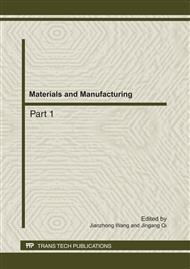p.440
p.444
p.448
p.452
p.456
p.460
p.466
p.470
p.475
The Blue Luminescence of CeCl3 Doped Aluminum Oxide Thin Film
Abstract:
Aluminum oxide film doped with Ce3+ has been deposited by the medium frequency reactive magnetron sputtering technique. The photoluminescence emission from these films show peaks at range of 374-405 nm. The relative intensity of these peaks is strongly dependent on the amount of Ce incorporated in the films. The presence of Ce3+ as well as the stoichiometry of these films has been determined by energy dispersive x-ray spectroscope (EDS) measurements. It is proposed that the light emission observed generated by luminescent center associated with cerium chloride molecular rather than to atomic cerium impurities. The reason for a dominance of the lower energy transition as the amount of Ce3+ in the oxide films is increased is that the energy difference of 4f1and 5d1 decreases, with the increase of the Ce3+ concentration. These luminescent films are potentially good candidates for photonics applications.
Info:
Periodical:
Pages:
456-459
Citation:
Online since:
July 2011
Authors:
Keywords:
Price:
Сopyright:
© 2011 Trans Tech Publications Ltd. All Rights Reserved
Share:
Citation:


